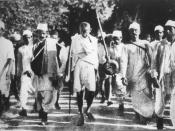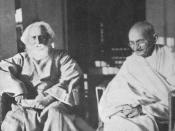Peace is defined as: 'prevention or refrain from strife . Customarily, the purpose of conflict is to achieve this 'prevention of strife,' but to reach such a state of calm, often violence and brutality is employed. Politically orientated movements such as the Cultural Revolution in China, and the Killing Fields of Cambodia are both examples of violence used to establish change. History's pages are soaked with the blood of those who have tried to effect change through violent means, some successful others not. But lurking in this ever increasing volume are those who have tried to procure a similar change, without the excess of carnage. 'Passive resistance' or peaceful protest is where the afore mentioned concept of accord is used to bring about a change, without the brute force that characterizes many a revolution. However, much like Mao and Pol Pot were instrumental in the success of their respective revolutions, even a revolution centered upon passive principles needs a leader.
India is a good illustration of a country which used peaceful protest to bring about dramatic political change, success largely due to the leader its, Mahatma Gandhi . Likewise, the remarkable situation which unfolded in the wake of a snap election in the Philippines is a demonstration of peaceful protest only made successful because of strong leadership. Corazon Aquino amazed the world when she led over 10,000 Filipinos to democracy, peacefully opposing the brutal Marcos regime of the Philippines. Similarly, in Poland, Lech Walesa an anti-government union activist, almost single handedly led the Poles out of communism and into democracy, without shedding a drop of blood. The element most common to each of these revolutions is the enormous part the respective leaders played in them. By looking closely at these three situations it becomes clear that leadership is as integral...


